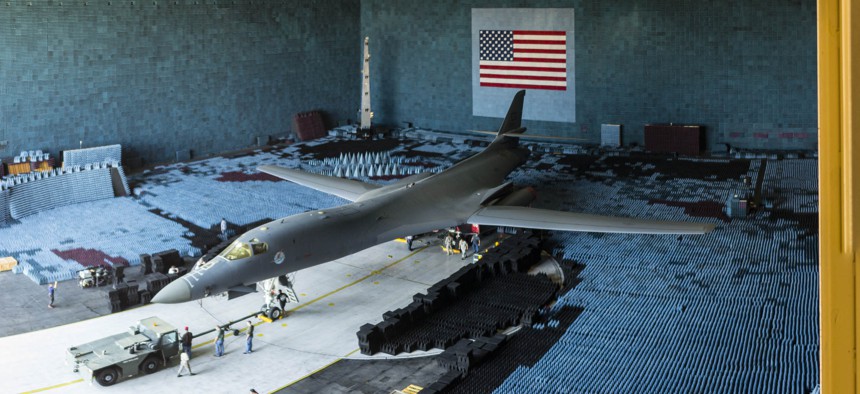
In this 2016 photo, a B-1B Lancer bomber is readied for electronic-warfare tests at the Benefield Anechoic Facility at Edwards Air Force Base, California. Christopher Okula / U.S. Air Force
Inside the Air Force’s anechoic chamber
Future platforms will require bespoke hardware to test at the Edwards facility.
EDWARDS AIR FORCE BASE, California—A cavernous facility in the Mojave desert free of sound and radio waves has tested some of the Air Force’s most advanced aircraft for more than two decades—and now is heading off mission-ending problems with next-gen satellites.
Edwards is home to the largest anechoic test facility in the world, which provides a virtual open-air range for the Pentagon’s platforms to test radio frequency systems.
The facility has recently tested its first satellite in decades, a next-gen satellite for GPS called NTS-3, which is projected to launch off of ULA’s Vulcan rocket.
The demand to test satellites in the chamber will “certainly be increasing,” since it’s a lot harder in space to turn a wrench on something that’s broken, said Lt. Col. Adam Brooks, commander of the Air Force’s 772nd Test Squadron.
If the satellite can’t be fixed remotely, “you could just end up with a dead satellite and billions of wasted dollars. So being able to test things here on the ground in a chamber, we’ve found problems on the recent tests that they wouldn’t have been able to find until it was in flight, and then it would have been too late,” Brooks said.
The Benefield Anechoic Facility, or the BAF, is covered almost top to bottom in radiation absorbent material, or “RAM,” a spiky-looking material that absorbs radio waves, giving the building a sci-fi appearance. Originally built to test the B-1’s radar warning receiver—a threat detection system—the facility later added a hoist to allow it to test fighters and other aircraft.
The facility creates a “pristine radio frequency environment,” a contrast to open-air environments, where cellphone towers and Wi-Fi signals can contaminate the electromagnetic spectrum for testing purposes, Brooks said.
The chamber will likely host multiple next-gen platforms coming to Edwards in the future, including the B-21 stealth bomber and the service’s secretive new fighter jet, called NGAD.
The earlier the Air Force can identify problems in these new programs, the easier they will be to fix, said Mario Dorado, an engineer with the 772nd squadron. “Once they’re fielded, it’s very expensive to go back and fix.”
Asked if 6th-gen aircraft will be able to use the BAF or if they will need a bigger space, Dorado said it depends on the size of the aircraft and the frequencies they want to operate, as well as the architecture of the plane.
“Several of them come with their own requirements and require even bespoke hardware to test them. I’ll just leave it at that,” Brooks said.
The base is constantly updating the facility—so it’s completely different from when it first reached initial operational capability in 1989 for the B-1 project, Brooks said.
“We’re not just trying to stay 10 steps ahead of our adversaries, we have to stay two steps ahead of ourselves, because there is new technology that’s coming down the pike and we have to be ready to verify and validate those technologies in here,” Brooks said.
Aircraft stay in the facility anywhere from a day to multiple months, depending on the test. The BAF has hosted a variety of customers, including car companies like BMW, and worked with allies such as Australia, Canada, Germany, and the UK.
Engineers see the need for an even larger chamber if they want to test in other parts of the spectrum. The material isn’t as effective at lower frequencies, because below one gigahertz, they start to get reflections or echoes, said Amarachi Egbuziem-Ciolkosz, an engineer at the squadron.
Additionally, if an aircraft has antennas spread all the way up to the wingtips and there’s not much space between the antenna and wall, it isn’t as good an approximation of free space, Brooks said.
The chamber is important for next-gen testing because it can simulate an enemy environment, Egbuziem-Ciolkosz said. “Countries are populated with radars. We simulate all those…so you can test the full thing, closer to an operational mode.”
The simulators in the BAF, which are basically radio frequency transmitters, are programmed to have the exact signature that foreign systems do, Egbuziem-Ciolkosz said.
“If you have intelligence data on a specific system from a specific country, we program upstairs and create that exact signal. And we do hundreds of those. Same with communications—we have simulators for creating communication signals,” Egbuziem-Ciolkosz said.
While created to provide a pristine radio frequency space, the facility also hides whatever system they are testing from adversarial eyes.
“It is a very isolated chamber. So mostly what we’re concerned about is providing that clean environment, [but] there may be secondary benefits to being a clean environment,” Brooks said.
There are other echo-free chambers in the U.S. Eglin Air Force Base has a smaller chamber that conducts similar work to the Edwards facility, but they can’t hoist the big aircraft, Dorado said.
“I’d say we have a lot more demand than we have capacity for,” Egbuziem-Ciolkosz said.
Because of the time it takes to set up the chamber and calibrate, Dorado said they are only able to get through about four to five customers per year.
“If we had another chamber, we could put more capability through here,” Dorado said.


